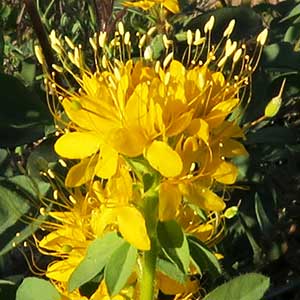Peritoma platycarpa
Peritoma arborea
golden bee-plant, golden spiderflower
bladderbush, bladderpod, burro-fat
densely branched basally; purple-tinged;
glandular-pubescent.
profusely branched; glabrate or puberulent (bark corky, twigs smooth).
(stipules scalelike, minute, obscured by pubescence);
petiole 1.5–4.5 cm;
leaflets 3, blade flat, ovate to obovate, 1–3.5 × 0.5–1.3 cm, margins serrulate-denticulate or entire, apex obtuse, surfaces glandular-pubescent.
petiole 1–3 cm;
leaflets 3, blade oblong-elliptic, 1.5–4.5 × 0.4–1.3 cm, margins serrate, apex acuminate to obtuse, surfaces glaucous.
1–3.5 cm (5–40 cm in fruit);
bracts unifoliate, obovate to spatulate, 3–25 mm.
1–3 cm (6–40 cm in fruit);
bracts unifoliate, obovate to spatulate, 2–15 mm.
7–17 mm.
7–15 mm (thickened in fruit).
sepals deciduous, distinct, yellow, awl-shaped, (3–)4–5(–6) × 3–7 mm, margins entire, densely glandular-hairy;
petals golden yellow, oblong, 6–12 × 0.3–0.4(–0.6) mm;
stamens yellow, 10–17 mm;
anthers 1.8–2 mm;
gynophore 10–18 mm in fruit;
ovary (compressed), 3.5–5 mm;
style 1–3 mm.
sepals persistent, connate ca. 1/2 of length, green, lanceolate, 4–7 × 2.2–4 mm, margins entire, glabrous;
petals yellow, ovate-elliptic, 8–14 × 4.2–5 mm, (apex acute);
stamens yellow, 15–25 mm;
anthers 2–2.5 mm;
gynophore (reflexed), 10–20 mm in fruit;
ovary 3–6 mm (often aborting in bud);
style 0.9–1.2 mm.
(pendent) not inflated, 12–25 × 8–12 mm, striate, (glandular-pubescent).
(tardily dehiscent), usually inflated,(valves sometimes 3), 20–30 × 6–12 mm, smooth.
10–20, brownish black, spheroidal, 3–3.2 mm, (glossy) smooth.
5–25, dark brown, obovoid, 6–7 × 5–6 mm, smooth.
= 40.
Peritoma platycarpa
Peritoma arborea
Peritoma platycarpa resembles some species of Cleomella in the absence of a nectary-disc, shape of the replum, and indument.
(Discussion copyrighted by Flora of North America; reprinted with permission.)
Varieties 3 (3 in the flora).
Peritoma arborea is woody and is variable in fruit size and shape. The large variability in fruit shape has led to the naming of varieties (L. D. Benson and R. A. Darrow 1945).
(Discussion copyrighted by Flora of North America; reprinted with permission.)
1. Capsules not inflated, narrowly fusiform. | var. angustata |
1. Capsules inflated, obovoid or subglobose | → 2 |
2. Capsules inflated, obovoid. | var. arborea |
2. Capsules strongly inflated, subglobose. | var. globosa |
- Local floras:
CA,
OR
- Local Web sites:
CalFlora,
CalPhotos,
Flora NW,
PNW Herbaria
WildflowerSearch
iNaturalist (observations)
- LBJ Wildflower Center
- SEINet
- Plants of the World Online
- Encyclopedia of Life
- Wikipedia
- Google Image Search
- Local floras:
CA
- Local Web sites:
CalFlora,
CalPhotos
WildflowerSearch
iNaturalist (observations)
- LBJ Wildflower Center
- SEINet
- Plants of the World Online
- Encyclopedia of Life
- Wikipedia
- Google Image Search


